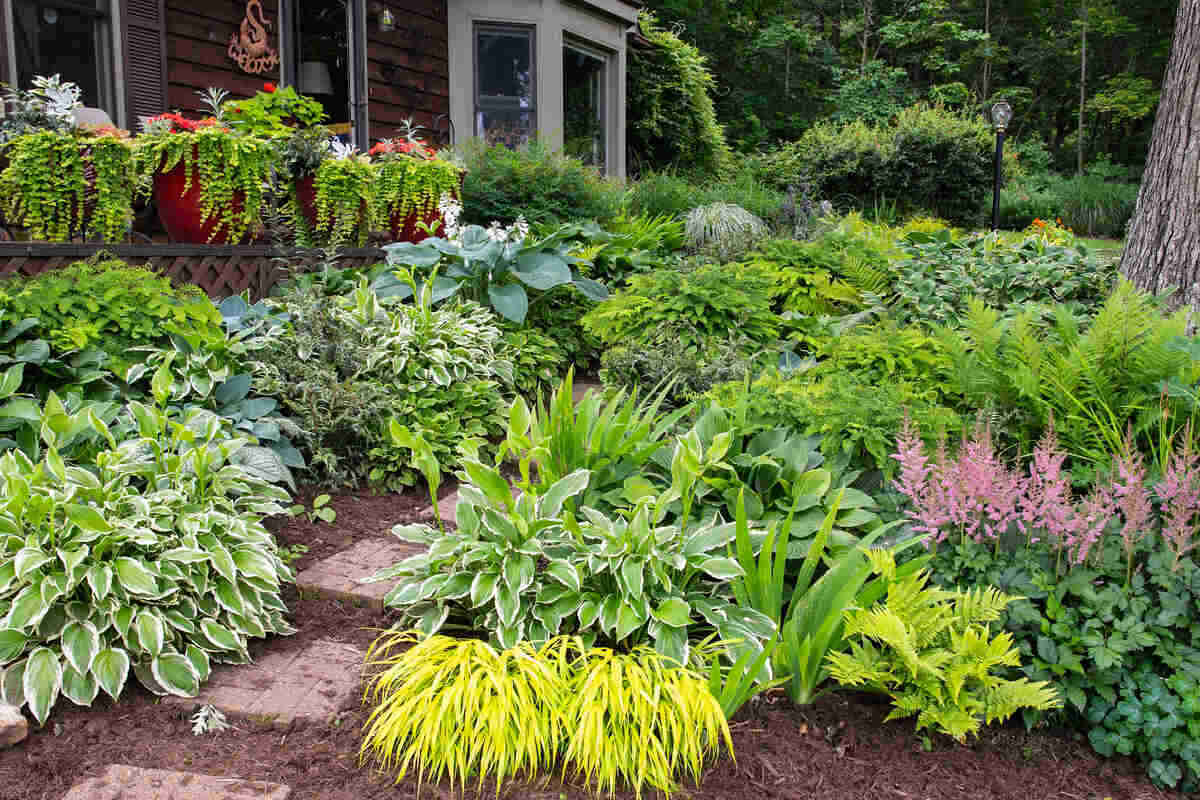
Think you need full sun to grow beautiful plants? These 10 best shade garden plants prove that shade in the landscape is a blessing–– not a curse.
After all, which garden would you prefer to enjoy on those hot summer days: The garden under the beating sun or the shade garden beneath a tree canopy? Whether your landscape has deep, partial, or dappled shade, there’s a shade-loving plant perfect for your yard.
Our list covers 10 shade garden plants, including trees, shrubs, flowers, foliage plants, and ferns. We’ve also included traits about each plant, including shade requirements, USDA hardiness zones, and soil preferences (keep in mind these listed traits vary among different cultivars and hybrids).
Ready to turn the yard’s shady spot into a calming retreat with the following shade plants?
Flowering Shade Garden Plants
Astilbe
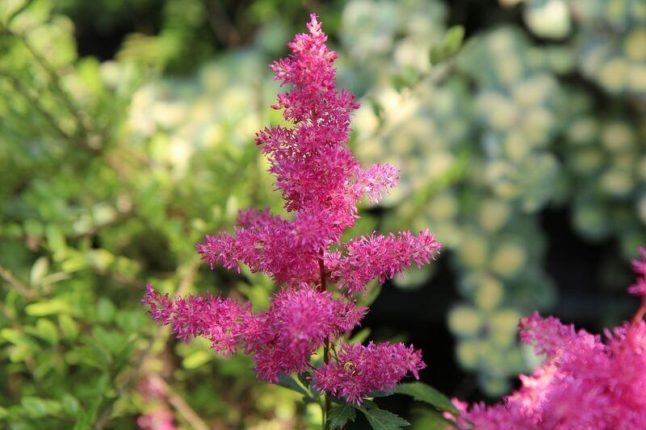
Photo Credit: Ettiene F-59 / Pixabay
Whoever says you can’t grow flowers in the shade hasn’t seen astilbe and its stunning blooms. Its spiky-shaped, fluffy plumes rise above fern-like foliage, showcasing a variety of visual textures. Depending on the astilbe variety, the flower plumes add splashes of reds, pinks, purples, and whites to the shade garden.
When you plant astilbe in the masses, the pop of color becomes a butterfly magnet. Expect to see the elegant blooms between late spring and late summer, although some varieties have a fall bloom time. The clump-forming perennial is resistant to deer and rabbits.
- Plant type: Flowering plant
- USDA Hardiness Zone: 3 to 8
- Sun: Partial shade
- Soil: Moist soil, well-draining, organically rich
- Duration: Perennial
- Bloom time: Between late spring and late summer
- Water needs: Medium to high
- Mature height: 1 to 5 feet
Foxglove
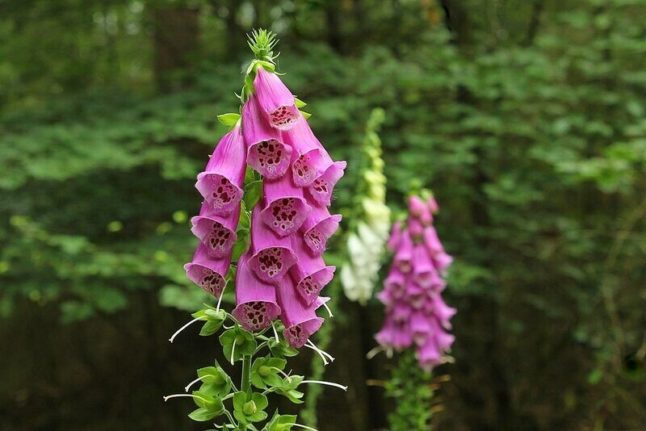
Photo Credit: Matthijs van den Berg / Wikimedia Commons / CC BY-SA 4.0
With their marvelous bright flowers and easy regrowth, foxgloves are popular among gardeners and hummingbirds. The tubular-shaped flowers grow in vertical, spike-shaped clusters, showing off purples, pinks, reds, yellows, lavenders, and whites.
Foxgloves are biennials, forming a clumped rosette of leaves in their first year and blooming in their second year. The good news is that you don’t need to replant them every two years because foxgloves drop their seeds. Cut the flower heads if you don’t want these plants reseeding in your garden.
Pro Tip: If you want your foxgloves to return every year, plant foxgloves for the first two years. If you only plant them once, you’ll only have new seeds every two years.
CAUTION: All parts of the plant are toxic when consumed.
- Plant type: Flowering plant
- USDA Hardiness Zone: 4 to 9
- Sun: Full sun to partial shade
- Soil: Moist soil, well-draining, organically rich, acidic to neutral
- Duration: Biennial or short-lived perennial
- Bloom time: Late spring to early summer
- Water needs: Medium
- Mature height: Up to 5 feet
Foliage Shade Garden Plants
Coleus
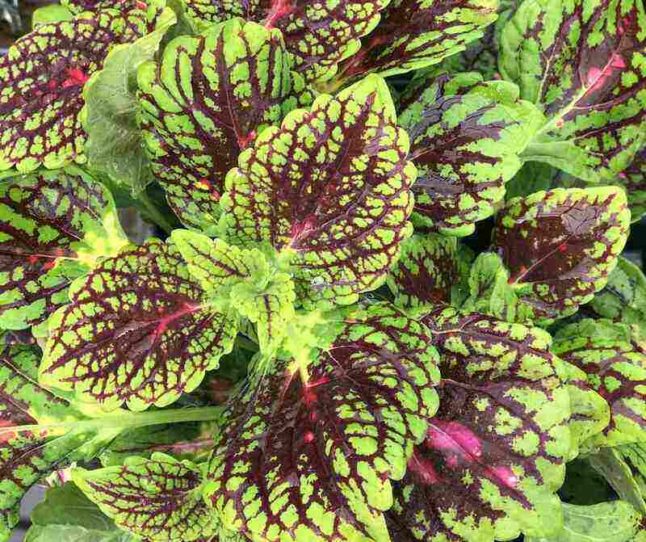
Photo Credit: kander / Pxhere / CC0 1.0
Coleus plants have striking variegated foliage colors, including greens, yellows, reds, maroons, and pinks. Add coleus plants to your shaded container garden to accentuate your showstoppers or grow them along the garden bed’s borders. Coleus plants grow best in the morning sun followed by afternoon shade.
If you want your coleus plants to have bushier foliage, pinch new growth that begins to grow horizontally. Pinching new growth encourages the plant to redirect its energy towards vertical, bushier development. Coleus flowers bloom in summer, but you may want to pinch the flowers to help the foliage thrive.
Coleus plants are hardy only in USDA Hardiness Zone 11, surviving the zone’s warm winters and returning the following year. Gardeners living in colder zones usually grow the plant as an annual because it won’t survive the winter. If you have cold winters, your options are to plant new coleus plants the following year or bring them indoors for the winter.
- Plant type: Foliage plant
- USDA Hardiness Zone: 11
- Sun: Dappled afternoon shade, with full sun in the morning hours
- Soil: Moist soil, well-draining, organically rich, slightly acidic
- Duration: Perennial, but typically grown as an annual (it can’t handle frost)
- Bloom time: Summer
- Water needs: Medium
- Mature height: 6 inches to 3 ½ feet
Elephant Ear
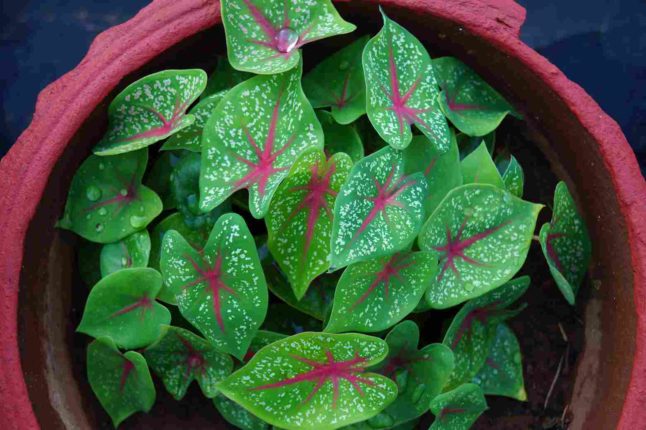
Photo Credit: SKsiddhartthan / Wikimedia Commons / CC BY-SA 4.0
Elephant ears are tropical plants favored for their large, heart-shaped leaves that mimic –– you guessed it –– elephant ears. Choosing the right elephant ear hybrid for your shade garden is like flipping through an art catalog of variegated patterns and colors.
Their waxy leaves are tremendous, growing up to 3 feet long and 2 feet wide (sometimes more). Elephant ears perform well in partial shade, though darker colored varieties typically grow best in full sun. Remember to leave enough space for your young elephant plants to grow, as they can reach up to 9 feet tall and possibly crowd out other plants.
- Plant type: Foliage plant
- USDA Hardiness Zone: 8 to 11
- Sun: Full sun or partial shade
- Soil: Moist soil, well-draining, organically rich
- Duration: Perennial
- Bloom time: Spring to summer
- Water needs: Medium
- Mature height: Up to 9 feet
Hosta
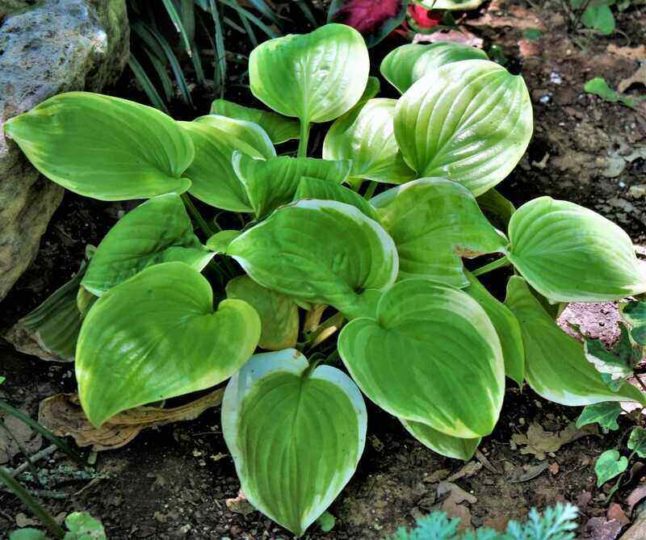
Photo Credit: Sheila Brown / PublicDomainPictures / CC0 1.0
If your landscape has areas with full or deep shade, hostas are the perfect fit. These plants grow well with little light, and their variegated foliage is attractive in the garden bed. Hosta varieties feature different leaf textures, shapes, sizes, and colors. Colors include blue tones, bright green, white, and gold, and leaf textures include veined, smooth, and puckered.
Also known as plantain lilies, hostas range from 6-inch tall miniature varieties to 4-foot tall, 6-foot wide giants. These plants also grow nicely in shaded container gardens.
- Plant type: Foliage plant
- USDA Hardiness Zone: 3 to 9
- Sun: Partial shade, full shade, deep shade
- Soil: Moist soil, well-draining, organically rich, slightly acidic
- Duration: Perennial
- Bloom time: Late spring to late summer
- Water needs: Medium
- Mature height: 6 inches to 4 feet
Sensitive Fern
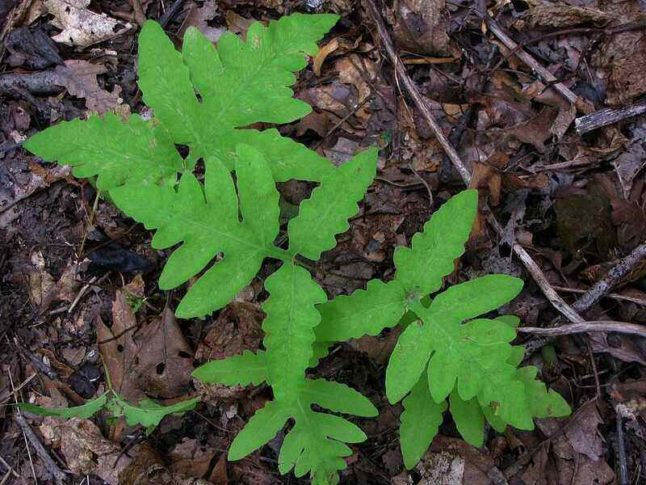
The sensitive fern loves to grow along streams, making it a great addition to your shaded bog garden or water garden (but it grows well in average garden soils, too). Drought-intolerant, the sensitive fern prefers moist to wet soils, so you don’t want your garden to dry out.
An excellent ground cover, the fern creeps along the garden floor via rhizomes and spores. But don’t expect its light green fronds to stick around in autumn, as it’s called sensitive fern for a reason: The fern despises cold weather and turns brown from the first fall frost.
- Plant type: Fern
- USDA Hardiness Zone: 4 to 8
- Sun: Partial shade, full shade
- Soil: Moist to wet soil, well-draining, organically rich
- Duration: Perennial
- Bloom time: Non-flowering plant
- Water needs: Medium to high
- Mature height: Up to 4 feet
Western Sword Fern
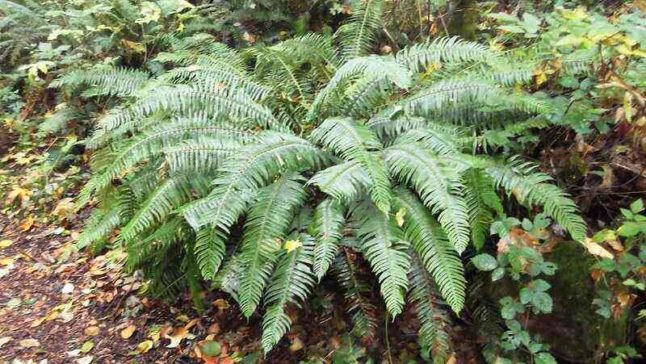
Photo Credit: brewbooks / Flickr / CC BY-SA 2.0
Is your garden growing feathers? The Western sword fern puts on a showy display of feathery, arching, dagger-shaped fronds. The fern can produce as many as 75 to 100 fronds, creating a dense cluster of swaying foliage. Not to mention these fronds can grow up to 4 feet long.
Not only is the Western sword fern a sight to behold, but it’s pretty resilient, too. The fern is an evergreen, which means it won’t lose its green color at the first sign of winter (unlike the sensitive fern). It also handles the occasional drought, so you won’t need to worry when rain is sparse. The Western sword fern is highly resistant to diseases, pests, deer, and rabbits.
- Plant type: Fern
- USDA Hardiness Zone: 3 to 8
- Sun: Partial shade, full shade
- Soil: Moist soil, well-draining, organically rich, slightly acidic
- Duration: Perennial
- Bloom time: Non-flowering plant
- Water needs: Medium
- Mature height: 3 to 6 feet
Trees and Shrubs for Shade Gardens
Flowering Dogwoods
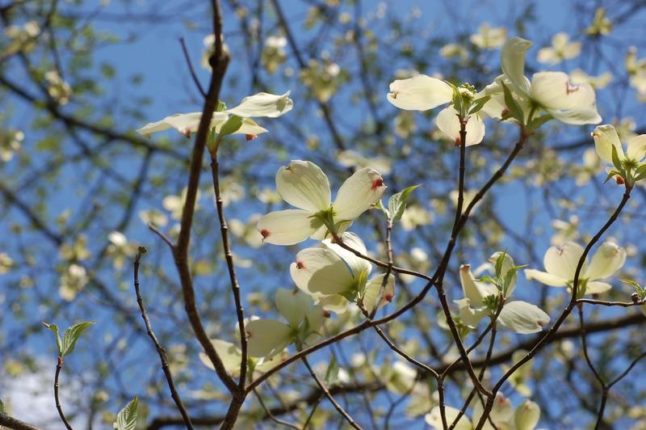
Photo Credit: Ram-Man / Wikimedia Commons / CC BY-SA 2.5
If you’re looking for a small tree that provides year-round beauty, the flowering dogwood is just what you need. The deciduous tree reaches 20 to 40 feet tall and fits nicely beneath forest canopies in partial shade.
In springtime, the thin branches have a flush of white, pink, or red flower bracts lasting between two and four weeks. Its foliage turns a warm reddish-orange in autumn, and the leafless winter branches grow bright red berries for local wildlife.
- Plant type: Tree
- USDA Hardiness Zone: 5 to 9
- Sun: Prefers partial shade but can tolerate full sun
- Soil: Moist soil, well-draining, organically rich, slightly acidic
- Duration: Perennial
- Bloom time: Early spring
- Water needs: Medium
- Mature height: 15 to 40 feet
Hydrangea
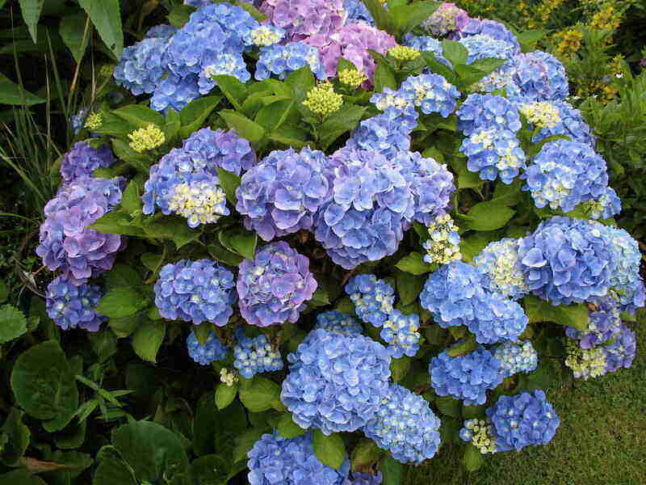
Photo Credit: Marc Ryckaert / Wikimedia Commons / CC BY-SA 2.5
Make a splash in your shabby chic shade garden with colorful hydrangeas. This shrubby plant rounds out the shabby chic garden style with its large flower clusters mimicking fluffy, round pom-poms. Its radiant blooms include blends of pink, lavender, blue, and purple flowers.
Have an antique fence, trellis, or arbor in your shabby chic garden? Consider adorning it with climbing hydrangea, a deciduous, semi-evergreen plant that climbs structures with its aerial roots.
Fall is the best time to plant your hydrangeas, giving them time to develop their roots before winter. Leave plenty of space between your young hydrangeas, as they’ll grow into bushy shrubs. The plant’s width and height will depend on your chosen hybrid variety.
- Plant type: Flowering shrub
- USDA Hardiness Zone: 3 to 9
- Sun: Full sun in the morning hours followed by partial shade in the afternoon
- Soil: Moist soil, well-draining, organically rich
- Duration: Perennial
- Bloom time: Late spring through early fall
- Water needs: Medium
- Mature height: Some varieties can grow as tall as 20 feet
Japanese Maple
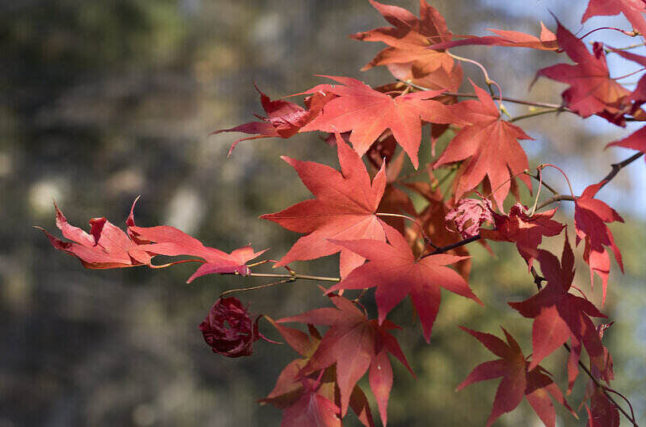
Photo Credit: C Watts / Flickr / CC BY 2.0
The key to designing any garden, including shade gardens, is to prepare for all the seasons. While your foxgloves and astilbe bring spring and summer flowers, the Japanese maple graces the autumn garden with flaming red, orange, and gold foliage. If you want winter interest, grow the coral bark Japanese maple for its fiery red bark (which looks stunning against a winter backdrop).
Native to Japan, Korea, and China, the small tree reaches heights between 10 and 25 feet tall, prefers partial or dappled shade, and is happy to grow underneath a forest canopy.
- Plant type: Tree
- USDA Hardiness Zone: 5 to 8
- Sun: Partial shade or dappled shade
- Soil: Moist soil, well-draining, organically rich, slightly acidic
- Duration: Perennial
- Bloom time: Early summer
- Water needs: Medium
- Mature height: 10 to 25 feet
FAQ About Shade Plants
You likely noticed that some shade plants prefer partial shade while others prefer full shade. But what’s the difference between all these different shade types? Let’s take a look:
• Dense shade (or deep shade): The shady area receives little to no sunlight all day, including reflected light.
• Full shade: The shady spot receives little to no sunlight all day but does receive reflected sunlight (unlike dense shade).
• Partial shade (or part shade): Area receives two to four hours of sunlight daily.
• Partial sun: Area receives four to six hours of sunlight per day.
• Dappled shade (or light shade): The area receives a dappled pattern of sunlight and shade as light filters through the tree foliage.
• Full sun: Area receives six or more hours of direct sunlight daily.
The 10 shade-loving plants listed above aren’t the only plants that flourish in shade gardens. Here are a few more to look for at your local garden center:
• Bleeding heart
• Coral bells
• Hellebore
• Impatiens
• Lungworts
• Begonias
• Spotted dead nettle
• Toad lily
• Foamflower
• Lily of the valley
• Primrose
• Geraniums
Like any other garden, a shade garden needs TLC to thrive and remain beautiful. Here are some tips on caring for your shade plants:
• Install a drip irrigation system to deliver water directly to the roots and avoid leaf wetness. Watering with a garden hose or sprinkler often results in wet foliage, creating a moist environment for pests and diseases.
• Add organic matter to the soil to increase soil fertility and improve drainage.
• Add organic mulch to the garden bed to help suppress weeds and deliver nutrients to the soil.
• Test your soil before adding plants to the garden bed. A professional soil test from your local cooperative extension or university provides detailed soil health results.
• Monitor the shade. When planning your shade garden, it can be hard to predict fluctuating shade levels from changing seasons and deciduous trees losing their leaves. Monitor the shaded area and prepare to move or swap struggling plants.
Building a shade garden requires time and energy. Like any garden, you’ll need to draw a design plan, prepare the garden’s soil, and choose your plants. Here are the basic steps to creating a shade garden:
• Find a shady location: Shade gardens grow well under forest canopies, shade trees, and behind buildings.
• Measure the space: To create a great design, you need to know how much space you’re working with.
• Determine the area’s shade level: Does the area have partial shade, full shade, or dense shade? The shade level will help you determine the best plants for your garden.
• Test your soil: Send the garden soil to your local Cooperative Extension or university for laboratory testing.
• Test for soil drainage: Some plants require poor draining soils, while others require well-draining soils.
• Choose shade-loving plants: Narrow down your plant choices based on the location’s shade levels, soil conditions, and drainage.
• Prepare the design: Sketch your design on paper so you can visualize the design before installing the plants and garden decor.
• Define the area: Lay down some rope to define the garden area.
• Remove turfgrass: Remove turfgrass within the roped area using a shovel, sod cutter, or newspaper (a thick layer of newspaper smothers the grass, though this takes a few months).
• Till the soil: Grab your shovel and turn over the soil 4 to 6 inches deep. Be careful not to damage tree roots.
• Loosen soil clumps: Break down soil clumps with a three-pronged cultivator.
• Add soil amendments: If you need to improve soil drainage or adjust the soil pH, work the necessary amendments into the top 6 to 12 inches of soil.
• Level the soil: Even out the garden bed with a garden rake to create a level surface.
• Add your plants: Now that you’ve prepared the garden bed, it’s time to add plants.
• Add mulch: Give your garden a nutritional boost with a 2-inch layer of organic mulch.
• Install garden decor: Want a trickling water fountain or outdoor lighting in your shade garden? Give your shade garden the finishing touch with your favorite garden decor.
If you’re not sure where to begin, check out “15 Shade Garden Ideas” for guidance and inspiration.
Spotlight Your Shade Garden
After installing the best plants for your shade garden, don’t let the surrounding weeds, overgrown grass, and scruffy edges steal the show. Hire a local landscape professional to banish the weeds, mow the grass, and trim the landscape edges so all eyes are on your shade garden (and not on the untidy crabgrass).
Main Image Credit: Mark Levisay / Flickr / CC BY 2.0